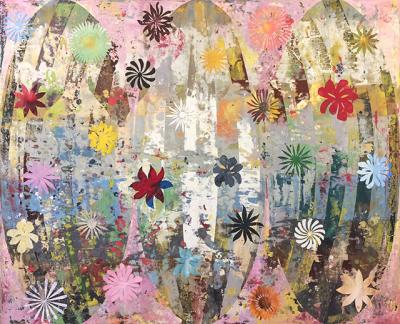Peace and Good Will in Nightingale Exhibition

There is no official theme to the grouping of paintings by Perry Burns, Cara Enteles, and Anne Raymond at the Sara Nightingale Gallery in Sag Harbor, but the bright colors and loosely abstract and floral themes are welcoming and cheerful. The show is not devoid of content, if one pauses to read between the lines, but it can also be seen as a welcome break from the grim headlines of recent weeks and a way to bring some optimism to the holidays and the darker days of approaching winter.
Closest to realism, Ms. Enteles seems to be predominantly concerned with plant life, which she paints on aluminum and Plexiglas panels. These untraditional supports give her works an unusual surface and background, an added luminescence that makes them seem otherworldly. Her silkscreen printing implies a mechanical process, but the oils she applies clearly indicate the artist’s hand. As much as the 19th-century American landscape painters chronicled a threatened idyll, Ms. Enteles also is engaged with the manipulation of nature by humans, often to the detriment of both.
If one sees allusions to environmentalism, the upbeat beauty of her work defuses any harsh critique. “I aim to be an advocate for nature,” she says in her artist statement, “to present it in a positive light.”
As pretty as they are with their purples, blues, pinks, and greens, highlighted with white, her subjects are often wildflowers, or what others might call weeds. With the exception of some bleeding hearts (a possible metaphor?), she highlights the uncultivated and unintentional. Her dill blossoms show the plant when it is of least utility to humans.
At the opposite end of the spectrum, Ms. Raymond’s moody and fiery abstractions are seemingly content free, but rich in emotional allusion. One of her stated goals is to imply that her canvases exist far past their physical boundaries. She is capturing nature but 10 times removed, as memory or inner reverie.
Ms. Nightingale has chosen a group of three paintings from the artist’s “Red February” series. While easy to dismiss initially as no more than a simple abstract exercise, these are powerful works that continue to burn brightly in memory, long past exiting the gallery. Perhaps it is the dramatic images coming from California the past couple of weeks, but the canvases seem alive with threat, passion, peril. Not quite the hell scape of those epic wildfires, their tangled construction puts off its own energy, setting itself up like a trap or some creation myth.
“Morning,” while less vehement, has a brooding intensity that the pretty collection of colored passages does little to ease. There is a hint of figuration in the composition, suggested forms seated in chairs overlooking a pool or small body of water with misty morning haze offering a heavy atmosphere. A painting called “Deep Series I” seems to be a melted version of one of Ms. Enteles’s compositions via Joan Mitchell. It is clearly the artist’s own, but in this installation, magical transformations occur, connections cross-pollinate, and life goes on, much relieved and richer for the experience.
Mr. Burns takes the symbolic and reduces it to its essence, much in the tradition of Islamic art. The “Flower Tapestries” on view are a direct outgrowth of the artist’s interest in that religion’s traditions of “depicting the human spiritual experience.”
Inspired by the Blue Mosque in Turkey and its decoration of thousands of hand-painted tiles with geometric patterns based on floral motifs, he came up with his own interpretation. “For me, these flowers are not just ornament, but structure, not just decoration, but essence. Each is different and unique, but together, come to form a whole — an interdependent structure that is a reflection of our own human experience.”
How does he communicate this visually? It appears with infinite variety. His floral motifs take on different guises: night lilies, chrysanthemums, or amalgams of unidentified signifiers. The flowers themselves are reduced to their heads, decapitated as it were, and stylized generalizations. Is there a black one in each grouping? Yes, but there are individual flower pieces as well, which have no black flower. At the current moment in history, a black flower, unnatural and foreboding, seems to foreshadow and represent the present at the same time. While the artist offers no direct connection to the events of 2017, his work is reminiscent of artists who have struggled to address their emotional state in the face of so much division and anger in order to move past it.
Mr. Burns speaks of his paintings in terms of visual mantras and enlightenment, of higher states and transcendental moments. Their melding of Abstract Expressionism with Islamic style patterns creates a simple visual unity in a world divided by race and religion and often artificially by fear of “the other.” This implied natural state is a not-so-subtle nudge toward peace on earth and good will to men.
